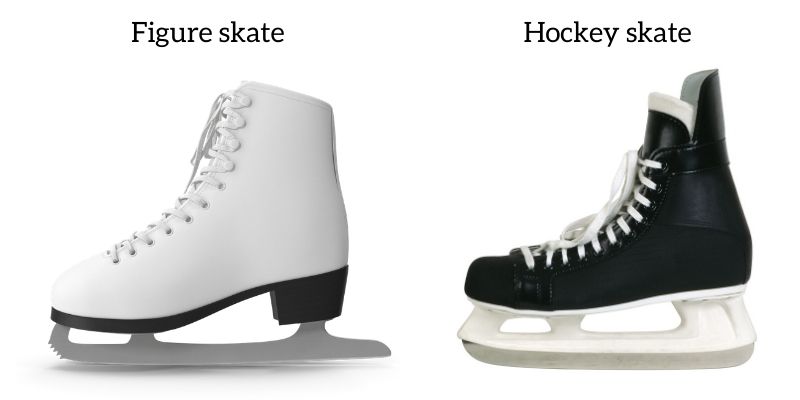Finding the right size of skates is critical. Here are some tips for your first-time ice skating:
In theory, it is your normal size or larger. Try them to find the most appropriate. They should feel snug. But they should not feel too tight. You must be able to move your toes (so that they don't go numb).
The main difference between the hockey skating boots and the figure skating boots are in their respective designs. While figure skating boots consist of multiple layers of leather, which makes them highly expensive, the boots worn by the hockey skater are made up of both leather and light plastics and are relatively cheaper.
Figure skating boots characteristics
- they have a small outer heel and a wooden sole inside to provide extra comfort;
- they are light, short and thin as compared to hockey skating boots when placed side by side;
- they are shaped specifically for performing precision moves and not speed runs as is deemed necessary for ice hockey skating.
Ice Hockey boots characteristics
- they are solely meant to cater to good support of the feet in order to make standing erect easy, something which is not a requirement for figure skating boots;
- they are taller, thicker and are heavily padded with foam to safeguard against collision with other hockey players and hits from hockey sticks and the puck;
- they are designed to take all kinds of abuse, for a long stretch of time.
Figure skating blades
The blades under the boots of a figure skater have a serrated edge, known as a toe pick, which allows the skater to perform various routines like jumping, spinning, stopping, etc. quite effectively.
Figure skating blades are longer and extend to the length of the boot
They are also wider and heavier than the blades on the hockey skating boots.
The blades are fixed to the boot by a pair of plates known as toe and heel plates.
Hockey blades
Hockey skating blades are narrow and deep so as to allow the player free movement at high speeds.
The blades are slightly curved at the back and front and do not extend beyond the length of the boot. They are more rounded and have less edges.
They are also comparatively much lighter than ice skating blades due to the smaller size.
The blades are fixed to the boots by a solid piece of plastic called tuuk.
Types of skating possible with figure vs hockey skates
Why choose Figure skates?
Pros of the figure skate
- PRECISION - The longer blade allows the skater to carve better arcs and more perfect lines.
- SUPPORT & FLEXIBILITY - The boot is tight enough to support the ankle, but flexible enough to flex and jump
- TOE PICK - The toe pick helps the skater execute jumps and pivots.
Advantages for the beginner
For a beginner, the figure skates are often considered a better option because they feel more stable: the blade is longer, the toe pick stops the skater from going too far forward on the blade and the tail prevents from leaning too far back.
The beginner often uses the toe pick to propel, getting speed faster at the beginning (even though it is not a good idea to propel with the toe pick).
What are figure skates best shaped for?
The skates are shaped to perform precision moves while gilding and acrobatic moves such as:
- Jumps: axel, lutz, salchow, to loop...
- Spins: turning fast on one foot in various positions
- Technical turns: rocker, twizzles
You won't be able to perform such moves with hockey skates.
Why choose Hockey skates?
Pros of the hockey skates
- PROTECTION - The boots protect the feet against the blades of other players and pucks flying at full speed
- SPEED - The lighter weight allows players to skate fast and stop fast
- TURNS - The blades are more curved at both ends. It makes it easier to turn for the skater.
Advantages for the beginner
For a beginner, the hockey skate option should not be overlooked. Especially if you are looking for speed. They are made for it.
Plus, as I said with the figure skates, beginners use the toe pick for propulsion which is not a good technic. With the hockey skate, there is no risk of doing that.
And hockey skates are lighter (in weight), so you can practice longer before fatigue sets in.
What are hockey skates best shaped for?
The skates are shaped to perform maneuvers and quick reflex movements such as:
- Starting fast - being explosive to chase the opponent
- Stopping fast, scraping the flat part of the blade over the ice surface
- Turning fast / changing direction - the puck flies all across the rink and you have to change directions very quickly.
How to take care of your skates
Irrespective of your choice between the two games, skates make up a vital part of the equipment of any player and are required to be serviced regularly in order to be in tip top condition at all times:
- Make sure the blades get sharpened regularly,
- Wear skate guards whenever walking off the ice,
- Dry your blades thoroughly after practice,
- Inside the bag, protect your blades with soakers,
- Once at home, take your skates out of the bag to dry,
- Carry your skates in a bag to protect them.


Skate Guards - figure skates Blade Soakers - Hockey skates




